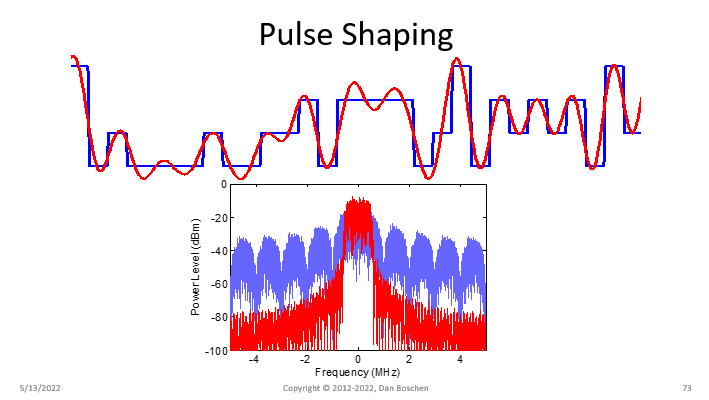As the transmitter is restricted to size and power considerations, there is no way to apply a SRRC filter at tx side. Can I just put a RC(raised cosine filter) at the rx side to alleviate ISI?
-
2$\begingroup$ That makes no sense: a matched filter is defined to be matched to the transmit filter, so, um, without transmit filters, no matched receive filters. Also, RC does not alleviate ISI – at all. Quite the contrary! Like any filter, it has the potential of introducing ISI. $\endgroup$– Marcus MüllerCommented May 13, 2022 at 11:03
-
2$\begingroup$ Can you explain what size/power constraints prevent applying a filter? $\endgroup$– EngineerCommented May 13, 2022 at 11:14
1 Answer
The RRC filter's only purpose in the transmitter is to reduce out-of-band emissions in the transmitted spectrum. Below shows a rectangular pulse waveform before and after using an RRC filter, where the upper plot is the time domain and the lower plot is the spectrum. Notice the significant reduction in sidelobe level and increase in spectral containment. Given our allocation of spectrum as a resource for wireless communications, this is highly desired, and in most cases required (one exception is GPS since the waveform as received as any potential interference to other receivers is already well below the spectral density of the noise floor).
If spectral containment isn't required then there is no reason for using an RRC filter. If spectral containment is required then additional filtering is needed one way or the other. Applying an RRC filter is a very efficient approach to doing this filtering and alleviates other filtering in the transmitter that would otherwise be needed. Further, when done in combination with the matched filter in the receiver as an additional RRC filter, the filtering is applied without introducing inter-symbol interference (ISI).
The purpose of the "matched filter" is to match all filtering that was applied to the transmitted waveform in order to provide an optimum correlation in the receiver. Optimum means the best signal to noise ratio after correlation in the presence of white noise (and would not be optimum under other noise conditions that are spectrally shaped). If an RRC is used in the filter, and then an RRC in the receiver would be the "matched filter" (although other filtering/ equalization for channel distortions which also cause ISI may be needed). If no filter is used in the transmitter (meaning we transmit rectangular pulses), then the matched filter in the receiver is itself a rectangular pulse (implemented as "integrate and dump" correlators).
For further details on how an RRC filter "eliminates ISI", please see this post. The eliminate ISI part means introducing relatively tight filtering without introducing ISI. To get tight filtering, long impulse responses are required. If not managed properly, the impulse response from prior symbols will interfere with subsequent symbols. Two Root-Raise-Cosine (RRC) filters in cascade become a Raise-Cosine (RC) filter, which has the unique property that it's impulse response passes through zero at every symbol duration- and thus we get bandwidth restriction with zero ISI!
Putting the complete RC filter on the Rx side would result in the same received waveform under high SNR conditions but doing this would not provide the optimum receiver with a matched filter which is matched to the waveform transmitted. Further we would have none of the benefit of using the RC filter in the first place since its sole purpose is to minimize spectral sidelobes in the transmitted signal (the spectrum in this case would be contained after it is received, which is of no useful purpose).
-
$\begingroup$ Thank you for your professional reply, Mr Boschen. "If spectral containment isn't required then there is no reason for using an RRC filter", in my situation, spectral containment is not of my concering. If RRC is availible at tx, the signal distortion might not be severe due to limited passband, but without RRC, in order to mitigate channel fading(underwater acoustic channel), do I have to do things like channel estimation or equalization to get a reasonable reciever performance? $\endgroup$– ztscottyCommented May 16, 2022 at 1:40
-
$\begingroup$ @ztscotty I don’t have any experience with the underwater acoustic channel but in general consideration is given to the symbol duration in comparison to the delay spread of the channel. If equalization is indeed needed then adding an RC filter in the receiver won’t serve that purpose. $\endgroup$ Commented May 16, 2022 at 1:46

